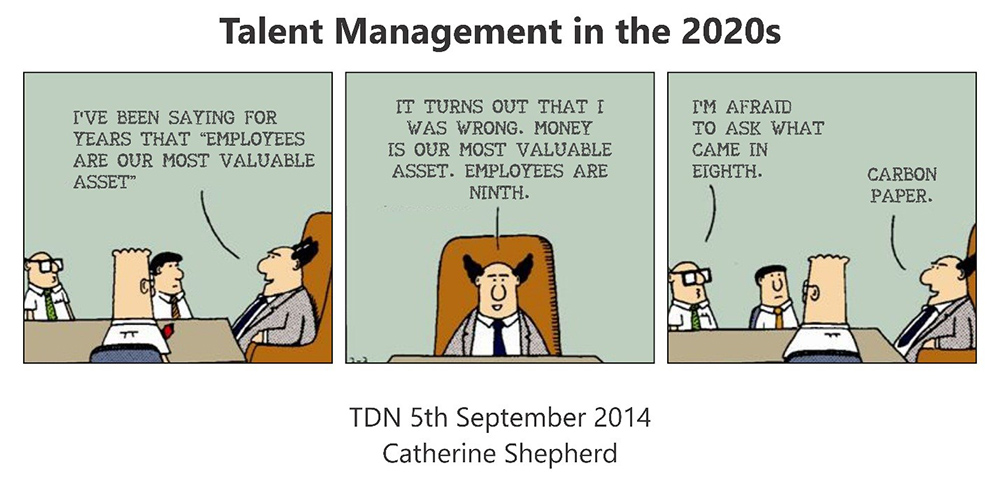
In a perfect organization, every employee will be the best performer, teams will work together toward a common goal and they will stick around till eternity. Alas, we live in an imperfect world and things are nowhere near this perfect. Hence arises the need for talent management. We haven’t arrived, yet, but we sure are on our way. Years of human resources grind has taught us that little changes can bring impressive results. During the journey we have forged and earned tools like people analytics, augmented reality and AI; Tools that can take us there and, hopefully soon.
What’s more? We have learned our way too. What began as an ambiguous short term human resource facilitation has evolved as one the most important pillars of modern world business planning.
Today, talent managers not only hold a seat at the table, they are expected to set the table for their organization too. The challenge and rewards are greater and so is the need for our readiness to face them.
It’s time for a shift in perspective. And here’s how it can be done:
An HR from a prominent organization said:
“We acquired one of our largest competitors and have redundant talent. How will we ensure we retain the best? Who will oversee the integration? What is the right management team for our new company? Who will help us focus on quality and cost containment, while pursuing new markets? And which employees will best fit the new culture?”
This is a run-of-the-mill mistake of the previous century that organizations committed and got away with but they cannot afford to do so anymore. With increasing competition, shrinking profits and contracting talent, such slipups cannot be ignored. And this isn’t just mergers and acquisitions we are talking about. In pursuit of small, short-term slapdash emergencies, organizations often lose focus away from the big, long-term objectives.
When you shoot without an aim you might end up killing your own army. Know the way before you choose to walk on it. Create goals and follow them through.

Goals demarcate employee job roles and establish the value of the employee to the organization. They improve engagement and hence achieve higher performance. Goals must be clearly communicated and reinforced across the organization so that teams know where they are required to work together and where they have cross purposes. Clarity of purposes reduce redundancy and speed up the processes.
Research by the Aberdeen Groups says that 84% of the best performing organizations connect their strategies with their goals. Proctor & Gamble sees “business decisions and talent decisions as one.”
Software comes to your aid here. When Loews hotels changed their goals they needed the employees to quickly realign with the new goals. They achieved the same by deploying performance and goals and succession and development software. As a result, they:

2020 is near and we reaffirm that employees are the most valuable resource, in fact, more than ever. Campbell’s CEO Doug Conant has said: “I would say CEOs, on average, understand and appreciate talent more than the everyday person because they know they can’t do their jobs without it.” That being said, a survey conducted for 40 companies worldwide revealed that almost all of them are short of the talent pipeline for high-performers.
Markets are increasingly becoming dynamic and changes (planned or sudden) need to be managed, deftly and efficiently. A good succession plan is as good as its weakest link. 97% of respondents say that they have failed to sync their established strategies with the growing and changing market needs and their process is strewn with weak links here and there. The results don’t surprise us. They jump on the succession planning wagon when an important leadership position becomes vacant unexpectedly. By the time they barricade this fire, flames go flying somewhere else.
For knowledge-intensive industries hiring from outside is a bleak hope. Knowledge-intensive industries have to develop and connect with their own talent. So for them, succession planning is a continuous on-the-toes affair. There is no one size-fits-all. Approaches differ. While Walmart is focused on hiring gig workers, Cognizant is using flexible jobs.
Defining a problem is halfway to its solution.
53% of best-performing organizations have defined their job competencies. 64% have established role models for them and have designed and rooted success profiles. These success profiles don’t just check competence and experience but they also address knowledge and personal attributes. However, we caution the excessive use of software here. Software would only take you so far but real talent management is a human strategy game and will continue to be so for a long time to come.
Here’s what we suggest:

CredBadge™ is a proprietary, secure, digital badging platform that provides for seamless authentication and verification of credentials across digital media worldwide.
CredBadge™ powered credentials ensure that professionals can showcase and verify their qualifications and credentials across all digital platforms, and at any time, across the planet.

Please enter the License Number/Unique Credential Code of the certificant. Results will be displayed if the person holds an active credential from TMI.